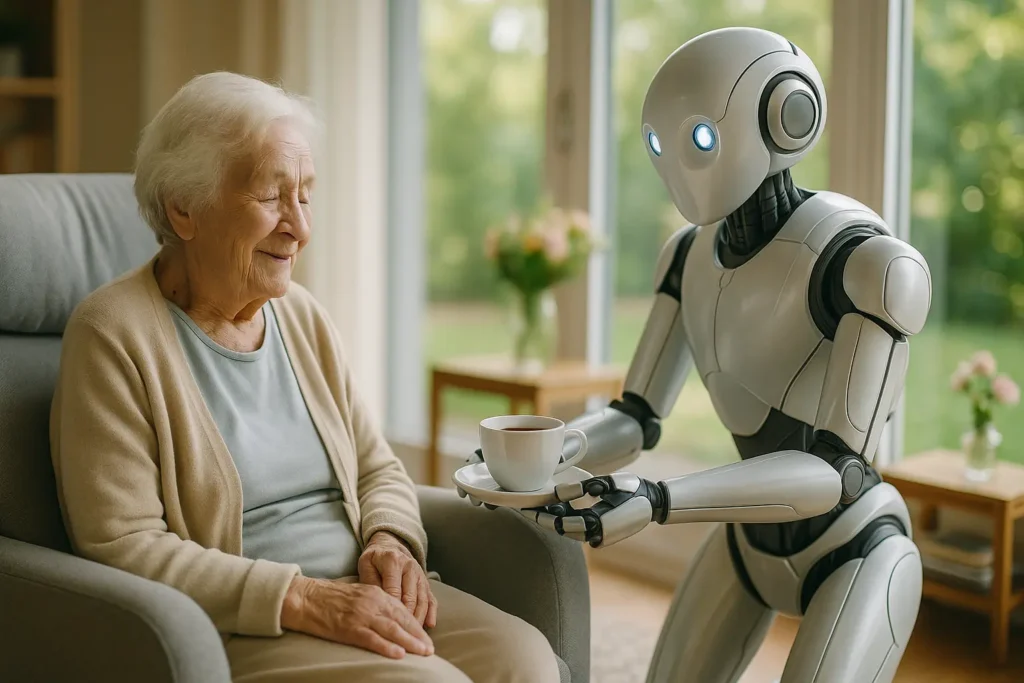In our rapidly advancing world, the lines between science fiction and reality blur more every day. Technological innovation is no longer a distant dream but a present reality reshaping our lives. Among these technological marvels, robotics stands out in its potential to transform various sectors. Healthcare, in particular, has seen a notable shift, especially in the realm of senior care. As the global population ages, we’re faced with the challenge of providing adequate support for our elderly. This calls for a novel approach that integrates robots and robotics into everyday life, promising not only improved care for seniors but also a quality of life that remains dignified and vibrant. Let’s explore how these robotic systems are revolutionizing the future of elderly care.
The Rise of Robotic Care in Elderly Healthcare
With the global elderly population on the rise, societies face an unprecedented challenge: providing continuous, high-quality care to our older generations. The care sector is often stretched thin, with limited resources and an increasing demand for personalized attention. Here, robotics emerges as a powerful ally.
From smart systems that monitor health metrics in real-time to robots that assist with daily tasks, technology is stepping in to alleviate the caregiving burden. Robotic caregivers are not a replacement but rather a complement to human care, offering a level of consistency and precision that human hands might find challenging to maintain.
Consider, for instance, robotic technology that helps elderly individuals maintain their independence. These machines aid in mobility, medication management, and even companionship. Smart home systems ensure that seniors can live safely, monitoring everything from heart rates to fall detection. By integrating these technologies, we create an environment where the elderly can thrive, with caregivers able to focus on emotional and psychological support rather than being consumed by routine tasks.
Moreover, the data collected by these systems provides invaluable insights for healthcare providers. Detailed analytics allow for personalized care plans, ensuring that each senior receives the right support at the right time. This fusion of technology and human care is creating a new paradigm where quality of life is prioritized through innovative solutions.
Advancements in Human-Robot Interaction
The success of integrating robotics into elderly care hinges on the quality of human-robot interaction. It’s essential that these machines not only function efficiently but also foster meaningful connections with their human counterparts.
Modern robotics focuses not just on functionality but on creating robots that understand and respond to human emotions. By using advanced sensors and artificial intelligence, these systems can recognize and adapt to the emotions of seniors, providing companionship that goes beyond just physical tasks.
Robotic systems are increasingly designed with human-like features, enabling them to engage in natural conversations, exhibit empathy, and even tell jokes. This humanized technology breaks down barriers, making seniors feel more comfortable and less isolated. Social robots have been shown to reduce loneliness, a common concern among the elderly, by facilitating interactions and encouraging participation in social activities.
Furthermore, as technology progresses, these interactions will become more seamless and intuitive. Future iterations of robotic companions will likely incorporate more advanced learning algorithms, enabling them to better predict and meet the needs of their human partners. This evolution not only improves the quality of care but also enhances the overall experience for both seniors and caregivers. By focusing on meaningful interactions, we ensure that robots contribute positively to the well-being and happiness of our older adults.

The Ethical Dimensions of Robotic Care
As we journey into the exciting world of robotic care, it’s crucial to address the ethical considerations that accompany this technological evolution. At the heart of these discussions is the balance between human touch and machine efficiency.
The introduction of robots in elderly care raises questions about privacy, autonomy, and the essence of human connection. It’s important to ensure that technology enhances rather than diminishes the dignity of our seniors. Data privacy, for instance, is a paramount concern. With robotic systems collecting vast amounts of information, safeguarding this data is essential to maintain trust and security.
Additionally, the reliance on robots must not lead to a reduction in human interactions. While these machines offer valuable support, they cannot replace the warmth and empathy of a human caregiver. A balanced approach is essential, where technology serves as an extension of human care rather than a substitute.
Moreover, we must consider accessibility. It’s vital to ensure that technological advancements are available to all seniors, regardless of socioeconomic status. This requires thoughtful policy-making and investment to bridge the digital divide.
As we navigate these ethical landscapes, it becomes evident that the key lies in a collaborative approach. By involving seniors, caregivers, and technologists in the conversation, we can create a future where robotic care is equitable, respectful, and truly beneficial for all.
A Future of Enhanced Living Through Robotic Care
As we look towards the future, the potential for robotics in elderly care is boundless. The innovations we’re witnessing today are merely the tip of the iceberg, with rapid advancements paving the way for a future where seniors can enjoy unprecedented levels of independence and quality of life.
Imagine a world where elder communities are supported by integrated systems that anticipate needs and adapt to changes in health conditions. Robotic assistants will not only help with physical tasks but will also serve as health monitors and lifestyle coaches, encouraging seniors to engage in activities that promote well-being.
Furthermore, the integration of technology will open doors to personalized healthcare. With the ability to predict potential health issues, robotics can play a pivotal role in preventative care, allowing seniors to stay proactive about their health.
Moreover, companionship through robotics will continue to evolve, with robots becoming more adaptive and emotionally intelligent. This ensures that seniors receive both physical assistance and emotional support, reducing loneliness and improving mental health.
In conclusion, the fusion of robotic technology and human care holds the promise of a future where seniors are empowered to lead fulfilling, independent lives. As we continue on this journey, it’s crucial to embrace innovation while remaining grounded in the values of compassion and respect. Together, we can create a future where aging is not feared but celebrated, with technology as our trusted ally.
In this age of rapid technological advancement, robotics in elderly care is not just a possibility; it’s an unfolding reality. As we’ve explored, these systems offer newfound independence, improved healthcare, and enhanced quality of life for our seniors. Yet, as we integrate these innovations, let us not lose sight of the human element that defines care.
Robotic technology should complement the warmth, empathy, and connection that only humans can provide. Our journey toward a future enriched by robots is about finding that perfect balance—a space where machines support people in leading lives of dignity and joy. Together, we can redefine what the future of elderly care looks like, embracing technology while cherishing the human spirit at its core.
FAQ
What are the primary benefits of using robotics in elderly care?
Robotics in elderly care offers numerous advantages, including enhanced safety and independence for seniors, the ability to perform routine tasks efficiently, and providing companionship, which can greatly improve mental well-being.
How do robotic assistants aid in day-to-day activities for the elderly?
Robotic assistants can help with a variety of daily activities such as medication reminders, mobility assistance, housekeeping tasks, and even providing meal preparation support, all while being personalized to the individual needs of the user.
Are there any specific challenges associated with implementing robotics in elderly care facilities?
Challenges include the high initial cost of robotic systems, the need for regular maintenance, potential resistance from seniors uncomfortable with technology, and ensuring that robots can effectively interact in human-centric environments.
How do robotics enhance safety measures in elderly care settings?
Robotics enhance safety by using sensors and AI to monitor for falls or medical emergencies, alerting caregivers instantly. They can also assist in navigating spaces safely, reducing the risk of accidents or injuries.
In what ways can robotics provide companionship to seniors?
Robotic companions can engage in conversations, play interactive games, and offer emotional support, helping to alleviate feelings of loneliness. They can also facilitate virtual connections with family and friends, ensuring seniors remain socially active.



